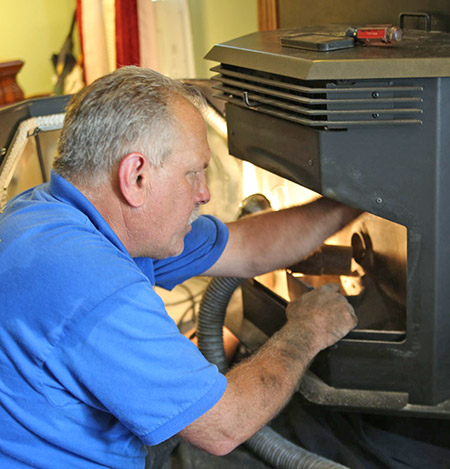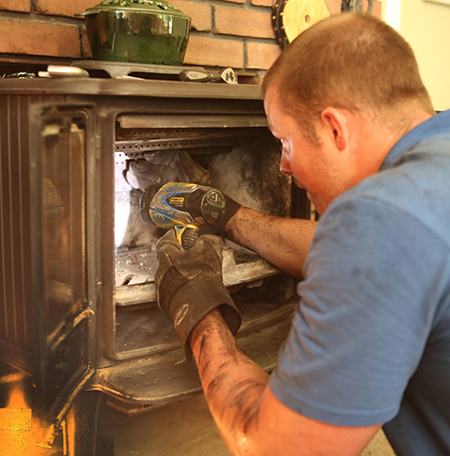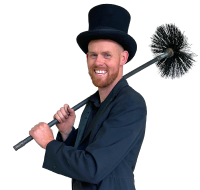Is My Fireplace Safe to Use?
 Are you eager for your next opportunity to get a roaring fire going when it’s cold outside? Many people are! The mistake commonly made, however, is lighting a fire in the fireplace without first knowing for sure that it’s safe. The leading reason for home heating fires is failure to clean chimneys. If there is an obstruction or debris in the chimney or if there is a large amount of creosote buildup, the result can be a hazardous chimney fire that spreads to the home. Without an annual chimney inspection done by a professional chimney sweep, these are conditions a homeowner can usually only guess at. It helps to have both the help of a chimney expert plus some know-how of your own, to have confidence that it’s safe to light a fire.
Are you eager for your next opportunity to get a roaring fire going when it’s cold outside? Many people are! The mistake commonly made, however, is lighting a fire in the fireplace without first knowing for sure that it’s safe. The leading reason for home heating fires is failure to clean chimneys. If there is an obstruction or debris in the chimney or if there is a large amount of creosote buildup, the result can be a hazardous chimney fire that spreads to the home. Without an annual chimney inspection done by a professional chimney sweep, these are conditions a homeowner can usually only guess at. It helps to have both the help of a chimney expert plus some know-how of your own, to have confidence that it’s safe to light a fire.
Basic parts of a fireplace
There are quite a few components to a fireplace and its venting system. When you understand how various parts work together and the importance of each, you are better equipped to enjoy safe fires. The following are basic parts of a fireplace and chimney that it helps to become familiar with, for safety and operational purposes:
Hearth. The floor area immediately in front of the fireplace is the hearth. The hearth must be made of non-combustible materials. The hearth protects the flooring from radiant heat, burning logs that may roll out, sparks, and flying embers. Popular materials for hearths include natural stone such as limestone, granite, marble, soapstone, and slate.
Firebox. The opening where fires are lit is called the “firebox.” Homeowners can help keep an eye on the condition of the fireplace by routinely inspecting the walls of the firebox. If there is any deterioration, such as cracks, repair is needed before using the firebox again. For safety reasons, the firebox must be sound, so that combustible materials aren’t exposed to extreme temperatures.
Damper. A lever inside the fireplace opens and closes the damper. The function of the damper is to either seal off the chimney or, when open, allow combustion gases to exit up the chimney. If a damper doesn’t operate properly, it should be repaired.
Smoke Chamber. The area just above the firebox and underneath the flue is the smoke chamber. This part of the chimney gently compresses combustion byproducts into the smaller chimney flue.
Smoke Shelf. The smoke shelf is in the smoke chamber. Cool air from outside moves down the flue and strikes the smoke shelf. There, it mixes with the warm air from the firebox or the room and goes back up the chimney, bringing combustion smoke along with it.
Flue. The chimney flue has a couple of very important purposes. First, the flue is a duct pipe or opening that conveys exhaust gases from a fireplace. Secondly, it protects combustible parts of the home from the intense heat produced in the fireplace. If the slightest damage occurs to a flue, it should be repaired or replaced before the fireplace is used again.
 Grate. The fireplace grate is an important part of the fireplace because it helps to ensure that a fire has adequate air. It’s important to safely clean out the ashes, if they prevent air from passing underneath the grate.
Grate. The fireplace grate is an important part of the fireplace because it helps to ensure that a fire has adequate air. It’s important to safely clean out the ashes, if they prevent air from passing underneath the grate.
Contact the Chimney Sweep Experts at Hudson Valley Chimney
With the above information, you are acquainted with basic aspects of your fireplace associated with safety and proper operation. Knowing about the various components of your fireplace together with depending on an expert chimney sweep for annual maintenance and cleaning can give you the confidence that your fireplace is indeed safe to use. Contact the chimney experts at Hudson Valley Chimney for chimney maintenance, cleaning, and repair.





